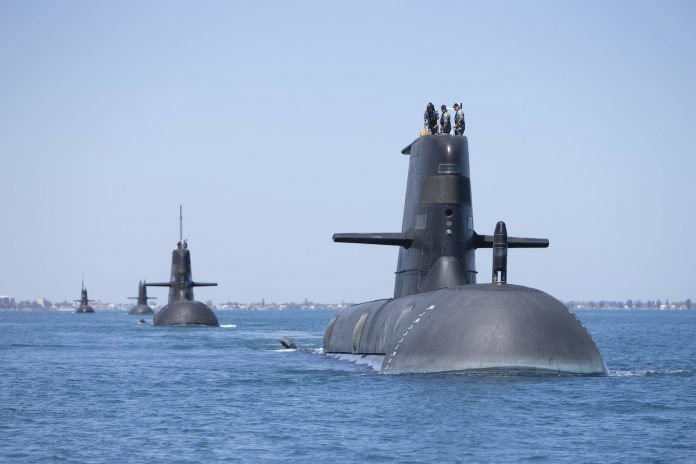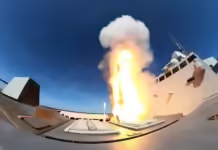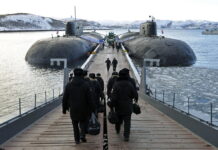
A year ago, the AUKUS agreement was formally announced between Australian and UK Prime Ministers Anthony Albanese and Rishi Sunak and US President Joe Biden. The agreement mapped out the “optimal pathway” for Australia, over the next two decades, to acquire between six and eight sub-surface nuclear propulsion boats, or more simply put, nuclear submarines.
The plan to acquire and build them has been the subject of ongoing debate. That’s largely because there’s limited understanding of the need for Australia to acquire submarines of this kind, John Blaxland* writes in The Conversation.
Concerns are also emerging over how committed the US really is to the deal, given doubts about whether it has the industrial capability to manufacture enough subs to meet its own needs. All this has fuelled speculation over the project’s viability.
So what is the US obliged to provide Australia with, in terms of submarines, under AUKUS? When will Australia likely get submarines under this deal? And how much can the domestic political and naval challenges facing the US affect how it meets its AUKUS requirements, particularly if Donald Trump is elected president?The state of play
Australia is now heavily invested in making AUKUS work, avoiding further policy U-turns.
Aided by some deft Australian diplomacy, in December 2023 the US Congress passed the National Defence Authorisation Actwhich authorised the transfer of three Virginia class submarines to Australia in the 2030s. Given the almost gridlocked US political system, this was once considered inconceivable.
The act also confirmed arrangements for training Australians in US and UK shipyards and, in turn, the maintenance of their submarines in Australia by Australians.
That does not mean, though, that everything is now set on autopilot. Understandably, the US reserves the right to fulfil its own domestic naval needs first.
But fears of the plans being derailed are misplaced, and suggestions Australia reverse course are problematic. Critics referring to the “profound impact” of any production slowdown have an important political point to make, drawing attention to the need for urgency and acceleration of the program, not cancellation.
Reports that the rate of production of these Virginia class submarines will dip to 1.3 per year has generated some alarm. This belies the fact the dip in production was anticipated and plans are underway to rectify the shortfall. The two US manufacturing companies that make submarines of this type, Electric Boat and Huntington Ingalls Industries, are taking measures to accelerate the rate of manufacture to 2.3 boats per year.
Australia’s financial and personnel contributions are helping. Plans are still in place that will enable Australia to purchase its first second-hand, but refurbished, Virginia class submarine in the mid-2030s.
That seems a long way off. To cover the gap, Australia’s existing diesel-electric Collins class submarines will be retained, supplemented by a Submarine Rotational Force-West, which will include UK and US submarines rotating through the Garden Island Naval Facility in Cockburn Sound, south of Fremantle.
While it doesn’t have the recognition of Pearl Harbor, Cockburn Sound is just as significant. In the Pacific war, about 170 allied submarines were based at Cockburn Sound from 1942 to 1945. From there, they protected Allied shipping and interdicted enemy sea lines of communication across the Indian Ocean, as well as the Malacca, Lombok and Sunda straits (in modern-day Indonesia), and across the South China Sea and around Formosa (now Taiwan).
Already, US Navy Virginia class subs have started making routine port calls there. The deterrent effect is already kicking in – and vociferous criticism of AUKUS suggests that some doth protest too much.
What if Trump comes to power?
In the meantime, some worry about what effect Trump’s prospective return to office might have on these plans.
AUKUS is understood to be a game-changer, and political leaders in Washington DC, both Democrat and Republican, understand this. It reflects an enduring overlap of Australian and US interests, not just sentimental attachments.
Australia benefits from US technology in bolstering its military and intelligence capabilities, reducing its “fear of abandonment”.
In turn, the US retains access to facilities in the East Asian hemisphere to monitor security trends and bolster deterrence in ways that suit their economic and security interests. This is appreciated by US security partners in Asia.
Moreover, while Trump has been critical of NATO and other allies, he has broadly avoided criticising Australia.
The overwhelmingly bipartisan December vote in Congress suggests that fears of the agreement losing support in the US are misplaced. There are no indications Trump is set to change that stance, and there are some compelling reasons for the next US administration to stay the course.
Why do we need new submarines anyway?
Back home, though, the Australian government’s message on these submarines has been clouded.
Eager to avoid drawing undue attention to the limitations of the current fleet, it has avoided talking up how potent and useful the replacement subs will be.
This is in spite of the fact that no matter how well maintained and updated the Collins are, such submarines are no longer viable for long-distance transits required for Australian submarine operations. This is not because of some intrinsic fault with the Australian submarines, but due to their ability to be detected from above.
The surveillance web of persistent and almost saturation satellite coverage, coupled with drones and artificial intelligence, makes the wake of the submarine funnels are detectable when they raise their snorkel to recharge batteries.
Much of this surveillance is believed to be operating from Chinese facilities in Antarctica, southern Africa and South America.
With stealth of submarines the only real advantage over surface warships, the usefulness of the current fleet on long transits sinks quickly. This leaves nuclear propulsion as the only viable path for countries that must traverse vast ocean distances even to cover their own waters.
For Australia, a transit from any capital city across to Fremantle cannot happen without exposure to detection. In wartime, that presents a catastrophic risk only surmounted by remaining underwater for the duration.
Beyond recouping stealth, the benefits of the new nuclear submarines are considerable. Australian submarines are intended to help manage vital shipping lanes.
The new vessels can travel faster than the current fleet (about 20 knots on average instead of six-and-a-half knots) and stay on station for longer, bolstering the deterrent effect.
The main constraint is food for the crew. A fleet of up to eight nuclear subs should generate three times the effective deployable time compared with the current Australian fleet because it can deploy faster, loiter longer and remain undetected, without needing to recharge batteries.
*John Blaxland is Professor of International Security and Intelligence Studies, and was, for a short while, appointed Official Historian of the Australian Signals Directorate to write a history of ASD. He is a former Head of the Strategic and Defence Studies Centre at the Australian National University



